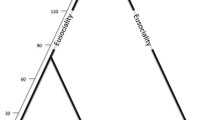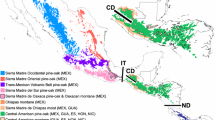Abstract
In the hymenopterans, haplodiploidy, leading to high-genetic relatedness amongst full sisters has been regarded as critical to kin selection and inclusive fitness hypotheses that explain the evolution of eusociality and altruistic behaviours. Recent evidence for independent origins of eusociality in phylogenetically diverse taxa has led to the controversy regarding the general importance of relatedness to eusociality and its evolution. Here, we developed a highly polymorphic microsatellite marker to test whether the eusocial ambrosia beetle Austroplatypus incompertus (Schedl) is haplodiploid or diplodiploid. We found that both males and females of A. incompertus are diploid, signifying that altruistic behaviour resulting from relatedness asymmetries did not play a role in the evolution of eusocialty in this species. This provides additional evidence against the haplodiploidy hypothesis and implicates alternative hypotheses for the evolution of eusociality.
Similar content being viewed by others
References
Boomsma J.J. 2007. Kin selection versus sexual selection: why the ends do not meet. Curr. Biol. 17: 673–683
Crozier R.H. 2008. Advanced eusociality, kin selection and male haploidy. Aust. J. Entomol. 47: 2–8
Farrell B.D., Sequeira A.S., O’Meara B.C., Normark B.B., Chung J.H. and Jordal B.H. 2001. The evolution of agriculture in beetles (Curculionidae: Scolytinae and Platypodinae). Evolution 55: 2011–2027
Foster K.R., Wenseleers T. and Ratnieks F.L.W. 2006. Kin selection is the key to altruism. Trends Ecol. Evol. 21: 57–60
Hamilton W.D. 1964. The genetical theory of social behaviour I, II. J. Theor. Biol. 7: 1–52
Hughes W.O.H., Oldroyd B.P., Beekman M. and Ratnieks F.L.W. 2008. Ancestral monogamy shows kin selection is key to the evolution of eusociality. Science 320: 1213–1216
Kent D.S. 2001. The Biology of the Ambrosia Beetle Austroplatypus incompertus (Schedl). Ph.D. thesis, University of Sydney. 229 pp
Kent D.S. 2008. Mycangia of the ambrosia beetle, Austroplatypus incompertus (Schedl) (Coleoptera: Curculionidae: Platypodinae). Aust. J. Entomol. 47: 9–12
Kent D.S. and Simpson J.A. 1992. Eusociality in the beetle Austroplatypus incompertus (Coleoptera: Curculionidae). Naturwissenschaften 79: 86–87
Kirkendall L.R. 2006. A new host-specific ambrosia beetle, Xyleborus vochysiae (Curculionidae: Scolytinae), from Central America breeding in live trees. Ann. Entomol. Soc. Am. 99: 211–217
Kirkendall L.R., Kent D.S. and Raffa K.A. 1997. Interactions among males, females and offspring in bark and ambrosia beetles: the significance of living in tunnels for the evolution of social behaviour. In: The Evolution of Social Behaviour in Insects and Arachnids (Choe J. and Crespi B., Eds), Cambridge University Press, Cambridge, pp 181–215
Marshall T.C., Slate J., Kruuk L.E.B. and Pemberton J.M. 1998. Statistical confidence for likelihood-based paternity inference in natural populations. Mol. Ecol. 7: 639–655
Normark B.B., Jordal B.H. and Farrell B.D. 1999. Origin of a haplodiploid beetle lineage. Proc. R. Soc. Lond. B 266: 2253–2259
Peer K. and Taborsky M. 2007. Delayed dispersal as a potential route to cooperative breeding in ambrosia beetles. Behav. Ecol. Sociobiol. 61: 729–739
Raymond M. and Rousset F. 1995. GENEPOP (version 1.2): population genetics software for exact tests and ecumenicism. J. Hered. 86: 248–249
Rozen S. and Skaletsky H.J. 2000. Primer 3. Code available at http://www-genome.wi.mit.edu/genome_software/other/primer3.html.
Smith S.M. and Stow A.J. 2008. Isolation and characterisation of novel microsatellite loci from the coppertail skink (Ctenotus taeniolatus). Mol. Ecol. Resour. 8: 923–925
Sunnucks P. and Hales D.F. 1996. Numerous transposed sequences of mitochondrial cytochrome oxidase I-II in aphids of the genus Sitobion (Hemiptera: Aphididae). Mol. Biol. Evol. 13: 510–523
West S.A., Griffin A.S. and Gardner A. 2007. Social semantics: altruism, cooperation, mutualism, strong reciprocity and group selection. J. Evol. Biol. 20: 415–432
Wilson E.O. 2008. One giant leap: how insects achieved altruism and colonial life. BioScience 58: 17–25
Acknowledgments
We are grateful to Richard Frankham, Stephen Hoggard and anonymous reviewers for helpful comments on the draft of the manuscript. This research was partially supported by an Australian Research Council grant (DP0879229).
Author information
Authors and Affiliations
Corresponding author
Rights and permissions
About this article
Cite this article
Smith, S.M., Beattie, A.J., Kent, D.S. et al. Ploidy of the eusocial beetle Austroplatypus incompertus (Schedl) (Coleoptera, Curculionidae) and implications for the evolution of eusociality. Insect. Soc. 56, 285–288 (2009). https://doi.org/10.1007/s00040-009-0022-4
Received:
Revised:
Accepted:
Published:
Issue Date:
DOI: https://doi.org/10.1007/s00040-009-0022-4




